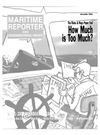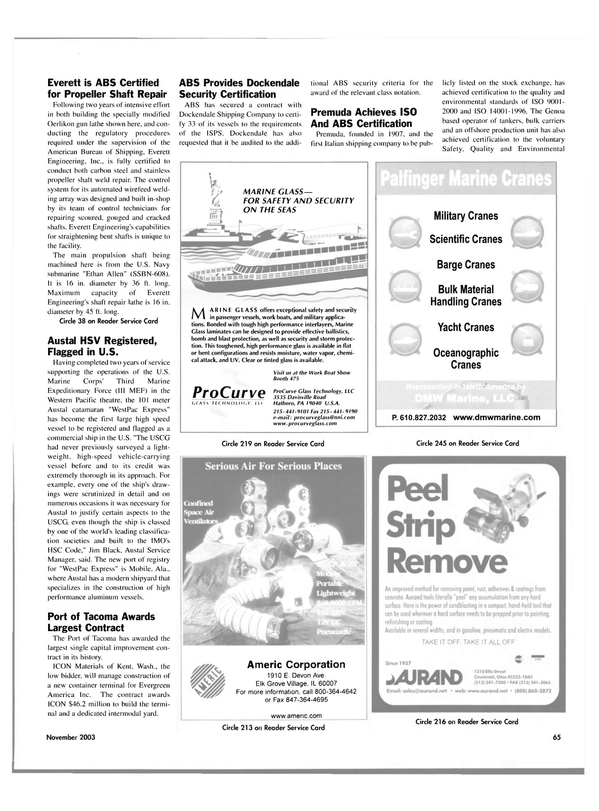
New Potency in Electronic Control
German predilection for technological advance permeates all areas of primary business and industrial activity, to the undoubted benefit of the competitive standing of its international market players.
In the maritime domain, a clear appreciation of the long-term operating benefits promised by the application of electronic regulation to massively powerful.
two-stroke propulsion engines is denoted by Hapag-Lloyd's selection of K98ME diesels for its next generation of linehaul vessels.
In explaining some of the rationale in opting for electronically controlled.
'cathedral' engines of the largest size produced to date, an article in a recent edition of the in-house publication Hapag-Lloyd New s illustrated the pragmatic approach to state-of-the-art technology.
The group's endorsement of a step change in engine design acknowledged the gains achievable through increased plant efficiency and performance level, all of which has a signal bearing on unit cost competitiveness and service dependability in the rigorous business of liner shipping.
Each of three 8.145-THU boxship newbuilds at the Hyundai yard will be powered by a single, 12-cylinder K98ME engine, for a maximum output of 93,360-bhp (68,640-kW). With the ME design, MAN B&W's Copenhagen two-stroke technicians have eschewed conventional camshaft drive in favor of electronically-controlled fuel injection and exhaust valve actuation. The arrangements will enable engine settings to be exactly matched to changing operating requirements throughout the voyage profile, offering the prospect of reduced overall fuel consumption, greater operational flexibility and lessened environmental impact.
One benefit will be the lower sailing speeds obtainable for restricted water transits as a consequence of the possibility to safely run the engine at extremely Circle 319 on Reader Service Card low crankshaft speeds. "As little as four knots are possible, and precisely this will mean greater maneuverability in the Sue/ Canal," pointed out Klaus Marek, head of Hapag-Lloyd's ship technology and inspection department. By comparison.
the company's four 7,500-TEU Hamburg Express-class vessels, fitted with conventional camshaft 12K98MC engines, have a minimum speed of six knots.
"The special plus of the electronically regulated main engine is that it uses two-percent less fuel," observed Marek.
The report in Hapag-Lloyd News indicated a potential annual saving for the nascent trio of 8.145-TEU containerships as around 3,000-tons, or $360,000.
More conservant use of heavy fuel oil, both in absolute terms and per unit of cargo volume, obviously has environmental as well as economic benefits, and Nox (oxides of nitrogen) engine exhaust emissions are expected to come down to 12.3 grams per kW-h (kilowatt-hour) as a result of the nomination of I2K98ME plant. "We have opted for diesel engines with electronic control systems because, in the future, we want to be able to react more flexibly to environmental requirements," Marek added.
MAN B&W's recent inclusion of a still wider-bore, new engine design in its ME program, in the shape of the mighty K108ME-C type, provides liner operators with an electronic, single-engine option for unit power requirements up to an astonishing 132,300-bhp.
Read New Potency in Electronic Control in Pdf, Flash or Html5 edition of November 2003 Maritime Reporter
Other stories from November 2003 issue
Content
- EU Single-Hull Phase-Out Elicits I MO Scorn page: 10
- Costa Victoria in for a Facelift page: 11
- Sustainable Growth for Liner Shipping page: 11
- World's Biggest LNG Carrier Due in 2005 page: 12
- Shipbreaking in the Spotlight at ILO page: 14
- Signet Martime Inks Garrett Contract page: 16
- IZAR Enters Fast Ship Project page: 17
- TEN Signs Time Charter for Aframax Olympia page: 17
- Cruise Port Expenditure to Reach $300M page: 18
- At Sea with U.S. Maritime Security page: 20
- NY Navigation Channels: The Really Big Dig page: 25
- Kvichak Delivers for NY page: 28
- Vosta LMG signs U.S. contract for 18" Cutter Suction Dredge design page: 28
- Senesco Marine Christens New Drydock page: 29
- Workboat Annual 2003 • Great Boats of 2003 page: 30
- Natter Passes Command of Atlantic Fleet page: 41
- Introducing Lean Shipbuilding to U.S. Yards page: 42
- IBM PLM Offers New Shipbuilding Solutions page: 46
- Cosco Dalian Leads China Ship Repair Business page: 50
- China: Growing Influence in All Matters Maritime page: 52
- L'Orange at Marintec China 2003 page: 56
- Shiport China 2004: Set in Tune with the Shipbuilding Industry page: 57
- New Aluminum Marine Alloy Specification Developed page: 58
- InspecTech Launches Line of "Smart" Windows page: 62
- New CEO at Kvaerner Philadelphia page: 62
- Asheim Takes Helm of Hoegh Fleet page: 62
- New Potency in Electronic Control page: 68
- Research as the Building Block page: 70
- Knowledge Interchange page: 71
- Surface-Protection Symposium Set for Liibeck page: 78
- Xybernaut Gets Patent for Detecting Corrosion on Maritime Vessels page: 79
- LCS Hull Concept Tests Move Ahead page: 80
- Hypertherm Enters Laser Cutting Market page: 81
- E-Ship: The Paperless Trail page: 82
- Cradle Tweendecks Patent for Langh Ship page: 86
- Optimizing Feed Rates For Crosshead Diesels page: 88
- Benjamin Vickers: 175 Years & Counting page: 89
- Life Boats by Ernst Hatecke Make the Plunge page: 90
- Clean Seal Celebrates 25 Years page: 91
- Netherlands Vessel First With New Engine page: 92
- ONR To Evaluate SeaCoaster page: 92
- KMY Helps Breaks the Ice in Russia page: 97
- Astander Completes CSO Deep Pioneer Upgrade page: 97
- Rickmers Singapore Christened page: 97
- Transas Releases New Version of Engine Room Simulator page: 98
- Merseyside gets first UK escort tug simulator page: 98


